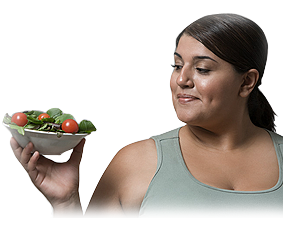Weight Loss SmartSiteTM | ||||||||||||||||||
Reading food labelsAbout food labelsAll packaged foods you buy must have a Nutrition Facts label. These labels give you nutrition information about the food. Knowing how to read these labels can help you choose healthy foods. Look for the Nutrition Facts label on the side or back of the food package or container. Serving sizeA serving size tells you how much of the food makes up one serving. Always check this first. Right below this, the label tells you how many servings are in the whole package. Many packages contain more than one serving. The rest of the label tells you how much of the following is in each serving:
Except for calories, these amounts are given in grams (g) or milligrams (mg). Some labels also list vitamins and other minerals such as calcium that are in the food. Figure out how many servings of the food you normally eat. You may notice that the amount you eat is actually two or more servings. That means you are eating two or more times the amount of the calories, fats, and other items listed on the label as the "per serving" amount. CaloriesCalorie information tells you the number of calories in one serving. Remember, if you eat more than one serving you are eating more calories. The % daily valueThe % Daily Value (Percent Daily Value or %DV) is found on the right side of the label. Experts have advised how many calories and how much fat, cholesterol, carbohydrates, sodium, and fiber you should eat each day. For each of these items, the % Daily Value tells you how much of that total amount is in one serving.
The % Daily Value is based on a daily diet of 2,000 calories. Your % Daily Value may be different if you are on a low-calorie diet. Even so, you can still use the number on the package as a guide. Total fat and cholesterolCheck the total fat in one serving. Also, look closely at the amount of saturated fat in a serving.
Pay attention to trans fats on any food label. These fats raise your LDL (bad) cholesterol and lower your HDL (good) cholesterol.
Cholesterol is listed under fat. A low amount of cholesterol per serving is best. Total carbohydrateCheck the carbohydrates next. It is listed in bold letters to stand out. Sugars, starch, and dietary fiber make up the Total Carbohydrate.
ProteinBetween 10% and 30% of your daily calories should come from protein. Protein keeps your muscles, skin, and immune system healthy. SodiumSodium is an essential element of all diets, but too much sodium can lead to higher blood pressures or worsen heart failure. You should consume no more than 2,300 mg of sodium per day, and many people should consume less, such as 1,500 mg per day. Vitamins and mineralsThe amounts of vitamins A and C, calcium, and iron in any food are listed on the food label below Protein. You will want to eat 100% of the Daily Value of these. IngredientsIngredients are what were used to make the food. They are often given below the Nutrition Facts label. Food makers must provide a list of ingredients somewhere on the package. They are listed in order from the most amount to the least used. A rule of thumb is, the fewer the ingredients a food has, the better. Fewer ingredients mean the food is less processed. If you have any food allergies, look for ingredients that you are allergic to. The front of food packagesThere are not many rules about what information can appear on the front of a food package. The true facts about the food are on the Nutrition Facts label. Many of the words on the front of the package are there to make the food appeal to you. Here is what some of these words and phrases mean:
Organic food labels have specific meanings:
Only foods that meet standards for "100% organic" or "organic" may display the USDA organic seal on the product. | ||||||||||||||||||
| ||||||||||||||||||
Review Date: 1/30/2018 Reviewed By: John E. Meilahn, MD, Bariatric Surgery, Chestnut Hill Surgical Associates, Philadelphia, PA. Review provided by VeriMed Healthcare Network. Also reviewed by David Zieve, MD, MHA, Medical Director, Brenda Conaway, Editorial Director, and the A.D.A.M. Editorial team. View References:  The information provided herein should not be used during any medical emergency or for the diagnosis or treatment of any medical condition. A licensed medical professional should be consulted for diagnosis and treatment of any and all medical conditions. Links to other sites are provided for information only -- they do not constitute endorsements of those other sites. No warranty of any kind, either expressed or implied, is made as to the accuracy, reliability, timeliness, or correctness of any translations made by a third-party service of the information provided herein into any other language. © 1997- A.D.A.M., a business unit of Ebix, Inc. Any duplication or distribution of the information contained herein is strictly prohibited. | ||||||||||||||||||
| ||||||||||||||||||













